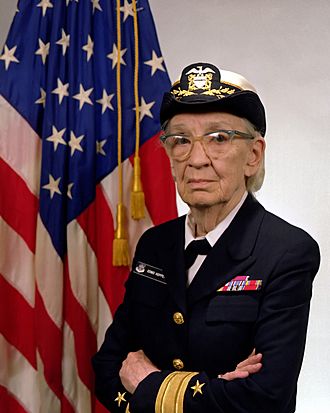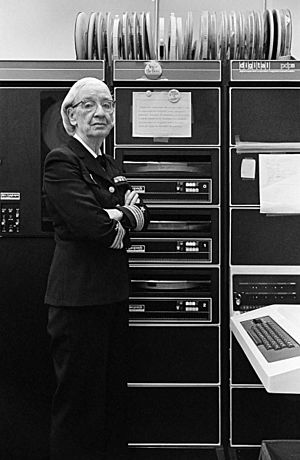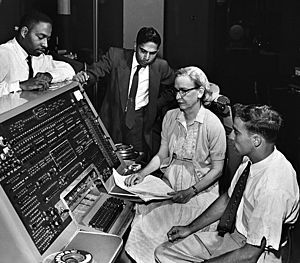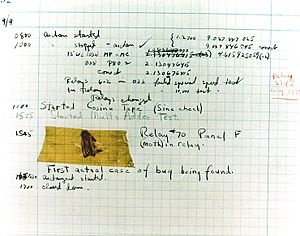Grace Hopper facts for kids
Quick facts for kids
Grace Hopper
|
|
|---|---|

Photograph from 1984
|
|
| Born |
Grace Brewster Murray
December 9, 1906 New York City, New York, U.S.
|
| Died | January 1, 1992 (aged 85) Arlington County, Virginia, U.S.
|
| Resting place | Arlington National Cemetery |
| Alma mater | Vassar College (BA) Yale University (MS, PhD) |
| Spouse(s) |
Vincent Foster Hopper
(m. 1930; div. 1945) |
| Awards |
|
| Military career | |
| Allegiance | |
| Service/ |
|
| Years of service | 1943–1986 |
| Rank | |
| Known for | |
| Scientific career | |
| Fields | Computer science Mathematics |
| Institutions |
|
| Thesis | New Types of Irreducibility Criteria (1934) |
| Doctoral advisor | Øystein Ore |
Grace Brewster Hopper (née Murray; December 9, 1906 – January 1, 1992) was an amazing American computer scientist, mathematician, and United States Navy rear admiral. She was one of the first people to program the Harvard Mark I computer. Grace Hopper was a true pioneer in computer programming. She invented one of the very first linkers, which helps computer programs work.
Hopper was the first to come up with the idea of programming languages that could work on different types of computers. This was a huge step forward! She created the FLOW-MATIC programming language. Later, COBOL, an early and important high-level programming language, was based on FLOW-MATIC. COBOL is still used in some places today.
Contents
- Early Life and Curiosity
- Grace Hopper's Education
- A Career in Computing and the Navy
- Retirement and Continued Work
- Personal Life
- Personality and Legacy
- Death
- Famous Stories About Grace Hopper
- Interesting Facts About Grace Hopper
- Grace Hopper Quotes
- Awards and Honors
- Places and Programs Named After Grace Hopper
- See also
Early Life and Curiosity
Grace Brewster Murray was born in New York City. She was the oldest of three children. Her parents, Walter Fletcher Murray and Mary Campbell Van Horne, had roots in Scotland and the Netherlands.
Grace was a very curious child, and she stayed curious her whole life. When she was seven, she wanted to know how an alarm clock worked. She took apart seven alarm clocks before her mom found out! After that, she was only allowed to take apart one clock at a time.
Grace Hopper's Education
For her high school education, Grace went to the Hartridge School in Plainfield, New Jersey. She first tried to get into Vassar College when she was 16, but her Latin test scores were too low. She was accepted the next year.
Grace graduated from Vassar in 1928 with a bachelor's degree in math and physics. She then earned her master's degree at Yale University in 1930. In 1934, Hopper earned her Ph.D. in mathematics from Yale. Her important paper, "New Types of Irreducibility Criteria," was published that same year. She started teaching math at Vassar in 1931 and became an associate professor in 1941.
When World War II started, Grace Hopper wanted to join the Navy. She was turned down at first because she was 34 and too light. Instead, she joined the Navy Reserves, leaving her teaching job at Vassar.
Hopper began her computer career in 1944. She worked on the Harvard Mark I computer team, led by Howard H. Aiken.
In 1949, she joined the Eckert–Mauchly Computer Corporation. There, she was part of the team that developed the UNIVAC I computer. At Eckert–Mauchly, she led the creation of one of the first COBOL compilers. She believed that computer programming should be easier to understand. She thought it should use English words instead of complex codes. Her compiler changed English terms into the machine code that computers could understand.
By 1952, Hopper had finished her program linker, which was first called a compiler. It was made for the A-0 System. During her time in the Navy, she also helped write three papers about her work on the Harvard Mark 1. She is also known for writing the first computer manual, called “A Manual of Operation for the Automatic Sequence Controlled Calculator.”
In 1954, Eckert–Mauchly chose Hopper to lead their automatic programming department. She helped release some of the first compiled languages, like FLOW-MATIC.
In 1959, she joined the CODASYL group. This group asked Hopper for her advice on creating a programming language that could work on any computer. This led to the COBOL language, which was based on her idea of using English words. Hopper worked hard to promote the use of COBOL throughout the 1960s.
In 1966, she retired from the Naval Reserve. But in 1967, the Navy called her back to active duty! She was promoted to captain in 1973.
Hopper was promoted to commodore on December 15, 1983, by President Ronald Reagan. She stayed on active duty for several more years, even past the usual retirement age, because Congress gave special approval. On November 8, 1985, the rank of commodore was renamed rear admiral (lower half). This made Hopper one of the Navy's few female admirals.
Retirement and Continued Work
After a career that lasted more than 42 years, Rear Admiral Hopper retired from the Navy on August 14, 1986. At that time, she was the oldest person serving in the Navy. At a special event in Boston on the USS Constitution to celebrate her retirement, Hopper received the Defense Distinguished Service Medal. This is the highest award given by the Department of Defense for non-combat service.
After retiring, she worked as a consultant for the Digital Equipment Corporation (DEC). She shared her amazing computer experiences with others. In this job, Hopper represented the company at industry events and served on various committees.
At DEC, Hopper mostly acted as a friendly ambassador. She gave many talks about the early days of computers, her career, and how computer companies could make things easier for users. She visited most of Digital's engineering places. People often gave her a standing ovation after her talks. Even though she was no longer a serving officer, she always wore her Navy full dress uniform to these lectures.

She kept her job with DEC until she passed away at age 85 in 1992.
Personal Life
In 1930, Grace Murray married New York University professor Vincent Foster Hopper. They divorced in 1945. She did not marry again and kept his last name.
Personality and Legacy
Grace Hopper was known for her lively and fun speaking style. She had many interesting stories from the early days of computing. Jay Elliot, who worked with her, said that Grace Hopper seemed "all Navy" on the outside, but inside, she was like a "Pirate" waiting to be set free.
Death
Grace Hopper died peacefully in her sleep on New Year's Day, 1992, at her home in Arlington County, Virginia. She was 85 years old. She was buried with full military honors in Arlington National Cemetery.
Famous Stories About Grace Hopper
- Debugging
While Hopper was working on a Mark II computer at Harvard University in 1947, her team found a moth stuck in a relay. The moth was stopping the computer from working! After they took the insect out, they taped it to the log sheet for that day. They wrote, “First actual case of bug being found.” Even though they didn't use the exact phrase "debugging" in their notes, this event is famous as a historical example of "debugging" a computer. Grace Hopper is often given credit for making the term popular in computing. The moth is still taped in the group's log book at the Smithsonian Institution's National Museum of American History in Washington, D.C..
- Nanoseconds
Hopper was famous for her "nanoseconds" visual aid. People, like generals and admirals, would ask her why satellite communication took so long. She started handing out pieces of wire that were just under one foot long—11.8 inches (30 cm). This is the distance that light travels in one nanosecond (a billionth of a second!). She called these pieces of wire "nanoseconds." She explained that this was the fastest the signals could travel. Later, she used the same wires to show why computers had to be small to be fast. At her talks, she would give out "nanoseconds" to everyone. She would also show a coil of wire 984 feet (300 meters) long, which represented a microsecond (a millionth of a second).
Interesting Facts About Grace Hopper
- Her great-grandfather, Alexander Wilson Russell, was an admiral in the US Navy. He fought in the Battle of Mobile Bay during the Civil War.
- During her lifetime, Hopper received 40 honorary degrees from universities all over the world.
- A college at Yale University was renamed in her honor.
- In 1991, she received the National Medal of Technology. This is a very high award for technological achievement.
- On November 22, 2016, she was given the Presidential Medal of Freedom after her death by President Barack Obama. This is the highest civilian award in the United States.
- When she retired, she was the oldest active-duty officer in the United States Navy.
- Admiral Hopper was the first person ever to be featured twice on the TV show 60 Minutes.
- She earned the nickname "Grandma COBOL."
- Nvidia, a big tech company, named their computer chip generations "Grace" (for CPU) and "Hopper" (for GPU) after her.
- The Navy's Hopper Information Services Center is named for her.
- The Navy named a guided-missile destroyer, the Hopper, after her.
- On June 30, 2021, a satellite named "Grace" (or ÑuSat 20) was launched into space in her honor.
Grace Hopper Quotes
- “A ship in port is safe, but that's not what ships are built for. Sail out to sea and do new things.”
- “The most dangerous phrase in the language is,‘We've always done it this way.’”
- “Don't try to manage people; you manage things; you lead people.”
- “The most important thing I've accomplished, other than building the compiler, is training young people. They come to me, you know, and say, 'Do you think we can do this?' I say, 'Try it.' And I back 'em up. They need that. I keep track of them as they get older and I stir 'em up at intervals so they don't forget to take chances.”
- “If it's a good idea, go ahead and do it. It is much easier to apologize than it is to get permission.”
- “Leadership is a two-way street, loyalty up and loyalty down. Respect for one's superiors; care for one's crew.”
- “One accurate measurement is worth a thousand expert opinions.”
Awards and Honors
Grace Hopper received many awards and honors throughout her life and even after her death.
Military Awards
| Defense Distinguished Service Medal (1986) |
Legion of Merit (1967) |
Meritorious Service Medal (1980) |
|||
| Presidential Medal of Freedom (2016, Posthumous) |
American Campaign Medal (1944) |
World War II Victory Medal (1945) |
|||
| National Defense Service Medal with bronze service star (1953, 1966) |
Armed Forces Reserve Medal with two bronze hourglass devices (1963, 1973, 1983) |
Naval Reserve Medal (1953) |
Other Important Awards
- 1964: Hopper received the Society of Women Engineers Achievement Award, their highest honor.
- 1969: She was given the first "Man of the Year" award (now called the Distinguished Information Sciences Award) by the Data Processing Management Association.
- 1971: The annual Grace Murray Hopper Award for Outstanding Young Computer Professionals was created in her honor.
- 1973: She was elected to the U.S. National Academy of Engineering.
- 1973: She became the first American and first woman of any country to be a Distinguished Fellow of the British Computer Society.
- 1987: She became the first person to receive the Computer History Museum Fellow Award.
- 1991: She received the National Medal of Technology.
- 1994: She was added to the National Women's Hall of Fame.
- 1996: The USS Hopper (DDG-70) ship was launched, nicknamed Amazing Grace.
- 2013: Google made a special Google Doodle animation for her 107th birthday, showing her using COBOL.
- 2016: She was posthumously awarded a Presidential Medal of Freedom.
- 2017: Hopper College at Yale University was named in her honor.
Places and Programs Named After Grace Hopper
- Grace Hopper Avenue in Monterey, California, is home to Navy computer centers.
- Grace Murray Hopper Park in Arlington County, Virginia, is a small park near where she used to live.
- Brewster Academy in Wolfeboro, New Hampshire, named their computer lab the Grace Murray Hopper Center for Computer Learning in 1985.
- Grace Hopper College is one of the student colleges at Yale University.
- An administration building at Naval Support Activity Annapolis is named the Grace Hopper Building.
- Hopper Hall is the Naval Academy’s newest academic building for cyber science. It's the first building at any service academy named after a woman.
- The US Naval Academy also has a supercomputer named "Grace."
- Building 1482 at Naval Air Station North Island, which houses the Naval Computer and Telecommunication Station San Diego, is named the Grace Hopper Building.
- Building 6007 in Aberdeen Proving Ground, Maryland, is named after her.
- Grace Hopper Lane is a street in Augusta, Georgia.
- Grace Hopper Academy is a programming school in New York City that aims to help more women become software engineers.
- A bridge over Goose Creek in Joint Base Charleston, South Carolina, is named the Grace Hopper Memorial Bridge.
- Minor planet 5773 Hopper is named in her honor.
- Grace Hopper Hall is a community meeting hall in Orlando, Florida.
- Women at Microsoft Corporation formed a group called Hoppers and created a scholarship in her honor.
- Since 2015, one of the competition fields at the FIRST Robotics Competition world championship is named for Hopper.
- A special professorship in computer sciences at Yale University is named in her honor.
- In 2020, Google named its new undersea network cable 'Grace Hopper'. This cable will connect the US, UK, and Spain.
See also
 In Spanish: Grace Murray Hopper para niños
In Spanish: Grace Murray Hopper para niños
- Bug (engineering)#History
- Code: Debugging the Gender Gap
- List of pioneers in computer science
- Women in computing
- Hopper (microarchitecture)
- Women in the United States Navy
- List of female United States military generals and flag officers
- Timeline of women in science




